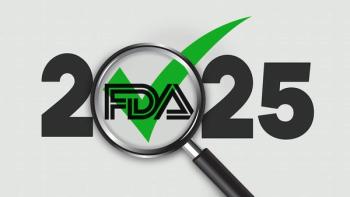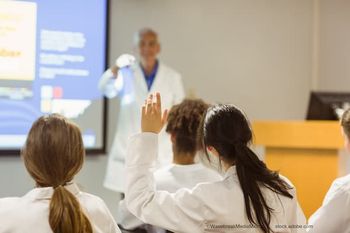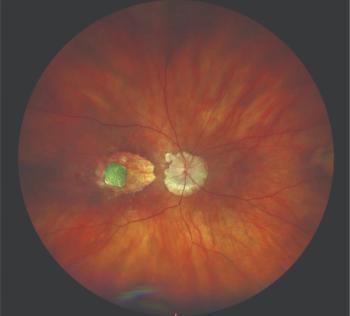
Bausch + Lomb, Novaliq publish pivotal Phase 3 data on NOV03
According to the companies, NOV03 consistently met primary endpoints for the signs and symptoms of dry eye disease linked with Meibomian gland dysfunction. A PDUFA data is set for June 28.
Bausch + Lomb Corp. and Novaliq GmbH, announced American Journal of Ophthalmology has published results from MOJAVE, the second pivotal Phase 3 trial for NOV03 (perfluorohexyloctane).1
NOV03 is being investigated to treat the signs and symptoms of
According to a news release, results from the first pivotal Phase 3 trial, GOBI, were published earlier this year in Ophthalmology.2 The U.S. Food and Drug Administration (FDA) assigned NOV03 a Prescription Drug User Fee Act (PDUFA) action date of June 28, 2023.
Yehia Hashad, MD, executive vice president, Research & Development and chief medical officer, Bausch + Lomb, pointed out in the news release that in addition to meeting both primary sign and symptom efficacy endpoints, NOV03 was shown to be very well tolerated in the MOJAVE study.
“These are all critical factors that must be considered when determining a treatment plan for someone with a chronic and progressive condition like dry eye disease associated with Meibomian gland dysfunction,” Hashad said in the news release. “Excess tear evaporation is a major factor in dry eye disease associated with Meibomian gland dysfunction, which remains largely unaddressed.”
Christina Ackermann, president, Ophthalmic Pharmaceuticals, Bausch + Lomb, pointed out that there presently are no FDA-approved prescription therapies available which directly target evaporation, leaving patients with limited treatment options.
“These data are consistent with the results seen in the first Phase 3 trial, and further support NOV03 as a new potential therapy designed to alleviate the signs and symptoms of dry eye disease associated with Meibomian gland dysfunction,” Ackermann said in the release.
According to the companies, DED affects millions of Americans and is one of the most common ocular surface disorders.1 MGD is a major cause of development and disease progression, affecting approximately nine out of 10 people with DED.2,3 DED due to MGD is caused by a deficient tear film lipid layer that leads to increased tear evaporation.4 There is currently no approved prescription eye drop in the United States indicated for DED associated with MGD.
“This is a year of exciting milestones for NOV03, with the publication of both sets of pivotal Phase 3 data, anticipated new topline data expected later this year from the KALAHARI 12 month safety extension trial, and the PDUFA action date in June,” Christian Roesky, PhD, CEO, Novaliq, said in the news release. “We look forward to continuing to work closely with Bausch + Lomb to advance NOV03 as a potential new treatment option, which, if approved, will help to address the needs of millions of Americans who suffer from dry eye disease associated with Meibomian gland dysfunction.”
About the MOJAVE Study
The data from the Phase 3, multicenter, randomized, hypotonic saline-controlled, double masked MOJAVE study was based on results from 620 subjects aged 18 years and older who were randomized to either receive treatment with NOV03 four times daily or hypotonic saline solution four times daily (n=311 NOV03; n=309 saline).
The two primary endpoints were change from baseline at Week 8 (Day 57 ± 2) in total corneal fluorescein staining (tCFS) and eye dryness Visual Analog Scale (VAS) score. Key secondary endpoints included change from baseline in eye dryness VAS score and tCFS at Week 2 (Day 15 ± 1) and eye burning/stinging VAS score and central corneal fluorescein staining (cCFS) at Week 8. Significant improvements vs. hypotonic saline solution were seen as early as day 15. Data highlights include:
Primary endpoints
At Week 8, reduction from baseline in tCFS was statistically greater in the NOV03 arm compared to the control saline group (least-squares [LS] mean treatment difference, -1.2 (95% confidence interval [CI]: -1.7, -0.8) (P < .001)).
At Week 8, VAS dryness score was statistically significantly improved in the NOV03 arm compared to control group (LS mean treatment difference, -10.2 (95% CI: -14.4, -6.1) (P < .001)).
Key secondary endpoints
At Week 2, tCFS and VAS dryness score were statistically significant compared to saline, with an LS mean treatment difference (95% CI) for change from baseline in tCFS of -0.6 (-1.0, -0.2) (P = .001) and VAS score of -7.8 (-11.3, -4.3) (P < .001).
At Week 8 VAS burning/stinging score and cCFS also favored the NOV03 group, with an LS mean treatment difference (95% CI) for change from baseline in VAS burning/stinging score of -7.3 (-11.3, -3.4) (P < .001) and cCFS of -0.3 (-0.5, -0.2) (P < .001).
In the study, NOV03 was well tolerated with few subjects experiencing ocular adverse events (AEs) (12.9% NOV03 group, 12.3% control group) or treatment-related ocular AEs (6.4% NOV03 group, 6.8% control group). Most AEs were mild to moderate in severity. The most common AEs (incidence ≥ 1%) experienced in the NOV03 group were blepharitis, conjunctival hyperemia, conjunctival papillae, ocular hyperemia, blurred vision, hordeolum (stye), and visual acuity reduction. No patients in either the NOV03 group or saline group had an ocular AE that led to treatment discontinuation or withdrawal from the study.
About NOV03 according to the companies, NOV03 is an investigational, proprietary, water-free, single-component preservative-free eye drop. In 2019, Bausch + Lomb acquired an exclusive license for the commercialization and development of NOV03 in the United States and Canada. Results from the pivotal Phase 2 trial (SEECASE) were published in Cornea in September 2021.
Data from the first pivotal Phase 3 trial (GOBI) were presented at the American Society of Cataract and Refractive Surgery (ASCRS) annual meeting in Washington, D.C. on April 24, 2022. Data from the second pivotal Phase 3 trial (MOJAVE) were presented at the Association for Research in Vision and Ophthalmology (ARVO) annual meeting in Denver on May 2, 2022. The clinical program for NOV03 concluded with the completion of a multi-center, open-label, single-arm, 12-month safety extension trial (KALAHARI).
In September 2022, Bausch + Lomb and NOV03 announced that the U.S. FDA had accepted the NDA filing for NOV03 and assigned a PDUFA action date of June 28, 2023.
References:
John D Sheppard, Fred Kurata, Alice T. Epitropoulos, Sonja Krösser, Jason l. Vitton, et.al. NOV03 for signs and Symptoms of Dry Eye Disease Associated With Meibomian Gland Dysfunction; the Randomized Phase 3 MOJAVE Study. Published March 20, 2023. doi: https://doi.org/10.1016/j.ajo.2023.03.008
Joseph Tauber, MD, Gregg J. Berdy, MD, David L. Wirta, MD, Sonka Krösser, PhD, Jason L. Vittitow, PhD. et.al. NOV03 for Dry Eye Disease Associated with Meibomian Gland Dysfunction. Published December 24, 2022. doi: https://doi.org/10.1016/j.ophtha.2022.12.021
Newsletter
Don’t miss out—get Ophthalmology Times updates on the latest clinical advancements and expert interviews, straight to your inbox.





